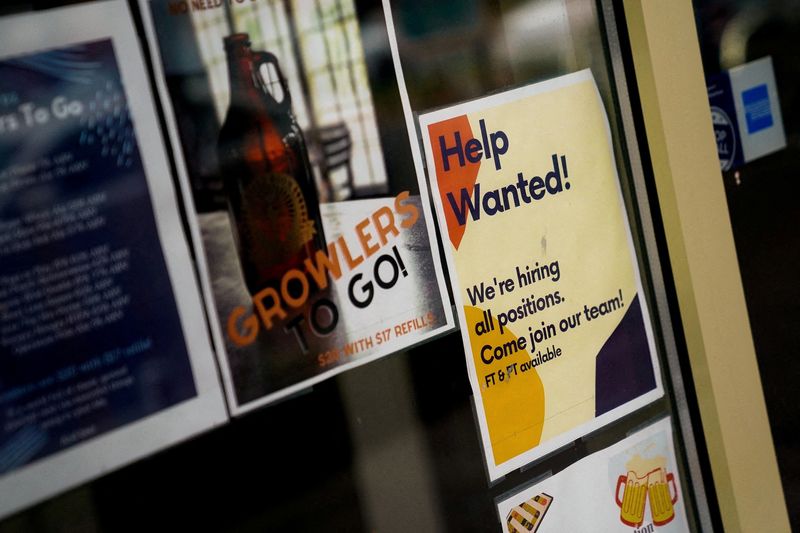By Lucia Mutikani
WASHINGTON (Reuters) - The U.S. economy grew at a slightly less brisk pace than initially thought in the second quarter as businesses liquidated inventory, but momentum appears to have picked up early this quarter as a tight labor market underpins consumer spending.
The report from the Commerce Department on Wednesday also confirmed that inflation pressures moderated last quarter. The economy continues to expand despite 525 basis points worth of interest rate hikes from the Federal Reserve since March 2022.
"The downgrade to second-quarter GDP growth will be welcomed by Fed officials and reinforces our expectations for a policy pause in September but the door will remain open to further tightening," said Lydia Boussour, a senior economist at EY-Parthenon in New York. "Data point to steady economic momentum into the second half of the year and confirm that a recession isn't on the near-term horizon."
Gross domestic product increased at a 2.1% annualized rate last quarter, the government said in its second estimate of GDP for the April-June period. That was revised down from the 2.4% pace reported last month. Economists polled by Reuters had expected GDP for the second quarter would be unrevised.
Inventory investment was sharply revised down to show it declining at a $1.8 billion pace instead of increasing at the previously reported $9.3 billion rate. Inventories were a small drag to GDP growth rather than adding 0.14 percentage point as estimated last month.
There were also downward revisions to business spending on equipment and intellectual products. These offset a slight upgrade to consumer spending, which accounts for more than two-thirds of U.S. economic activity. Trade subtracted more from GDP growth than initially estimated.
The economy grew at a 2.0% pace in the first quarter. It is expanding at a pace well above what Fed officials regard as the non-inflationary growth rate of around 1.8%.
The economy's resilience raises the risk of borrowing costs remaining higher for a while, but slowing inflation is fueling optimism that the U.S. central bank is probably done hiking rates and could engineer a "soft landing." Most economists have walked back their forecasts for a recession this year.
Stocks on Wall Street were trading higher. The dollar fell against a basket of currencies. U.S. Treasury prices were mixed.
INFLATION COOLING
The government's measure of inflation in the economy, the price index for gross domestic purchases, rose at a 1.7% rate, revised down from the 1.9% rate estimated last month. This followed a 3.8% pace of increase in the first quarter.
The personal consumption expenditures price index (PCE) excluding food and energy advanced at a 3.7% rate, lowered from the previously reported 3.8% pace. That was a sharp slowdown from the 4.9% pace logged in the January-March quarter. The Fed watches the PCE price indexes for monetary policy.
Though the labor market is slowing - the ADP National Employment Report showed on Wednesday that private payrolls rose by 177,000 jobs in August after increasing by 371,000 in July - conditions remain tight as employers hang on to their workers after hiring difficulties during the COVID-19 pandemic.
That is keeping wage growth elevated, helping to drive consumer spending. Retail sales increased strongly in July, while single-family homebuilding was robust.
But inventory data was mixed in July, a third report from the Commerce Department showed on Wednesday. Wholesale inventories slipped 0.1% after dropping 0.7% in June.
Stocks at retailers climbed 0.3% in July after gaining 0.5% in the prior month. Excluding automobiles, retail stocks rose 0.1% after increasing 0.2% in June. This component goes into the calculation of GDP. The goods trade deficit widened 2.6% to $91.2 billion in July, the government also reported.
"Even with this widening during the month, the July reading was still narrower than the average for second quarter, and we think that net exports are on pace to boost GDP growth in third quarter on average," said Daniel Silver, an economist at JPMorgan in New York. "Real inventories declined in the second quarter, so we think the bar is pretty low for the change in inventories to boost growth in third quarter."
Growth estimates for the third quarter range from below a 2% rate to a 5.9% pace. The wide forecast range indicates greater uncertainty about the economy's health.
An alternative measure of growth, gross domestic income, or GDI, rebounded at a 0.5% rate in the second quarter. GDI, which measures the economy's performance from the income side, contracted at a 1.8% pace in the first quarter.
In principle, GDP and GDI should be equal, but in practice differ, as they are estimated using different and largely independent source data.
The average of GDP and GDI, also referred to as gross domestic output and considered a better measure of economic activity, increased at a 1.3% rate in the April-June period, up from a 0.1% growth pace in the first quarter.

The income side of the growth ledger is supported by wages. National after-tax profits without inventory valuation and capital consumption adjustments, conceptually most similar to S&P 500 profits, increased $67.6 billion in the second quarter, or at a 2.5% pace, after declining at a 1.2% rate in the January-March period. Profits were down 9.4% from a year ago.
"Tighter monetary policy from the Fed may have been more effective in slowing growth than the real GDP numbers taken alone might show," said Gus Faucher, chief economist at PNC Financial (NYSE:PNC) in Pittsburgh, Pennsylvania. "The real test of the effectiveness of monetary policy will come from the labor market, which remains too tight for the Fed."